ECU RENAULT FLUENCE Z.E. 2012 User Guide
[x] Cancel search | Manufacturer: RENAULT, Model Year: 2012, Model line: FLUENCE Z.E., Model: RENAULT FLUENCE Z.E. 2012Pages: 195, PDF Size: 5.23 MB
Page 49 of 195
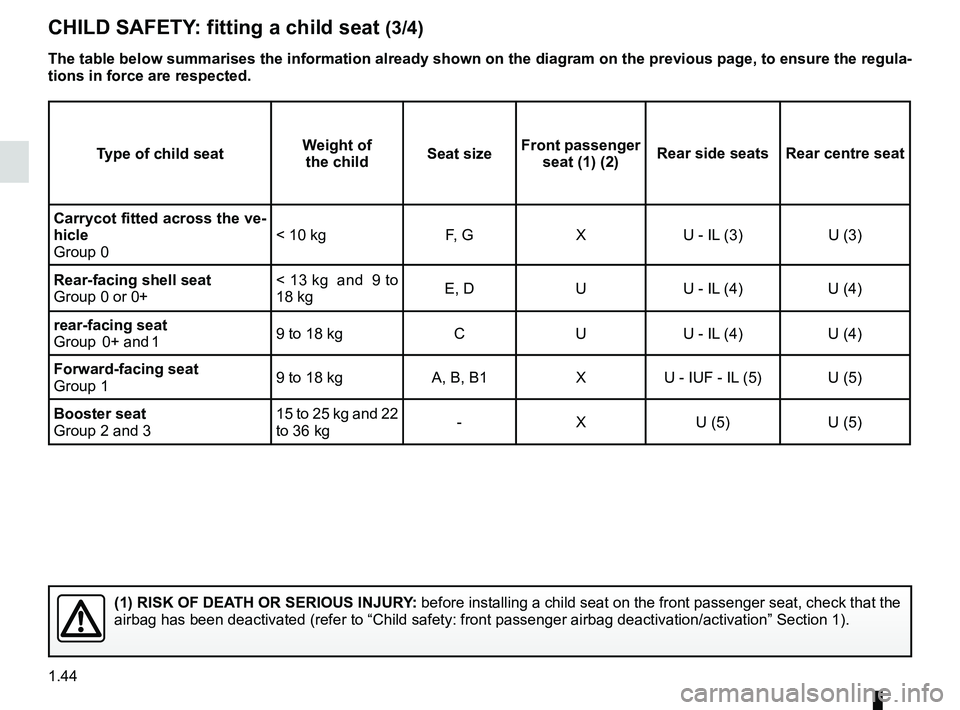
1.44
ENG_UD21488_3
Sécurité enfants : installation du siège enfant (L38 - X38 - R\
enault)
ENG_NU_914-4_L38e_Renault_1
Jaune NoirNoir texte
chilD SAFetY : fitting a child seat (3/4)
the table below summarises the information already shown on the diagram on the previous page, to ensure the regula-
tions in force are respected.
type of child seat Weight of
the child Seat sizeFront passenger
seat (1) (2) rear side seats
rear centre seat
carrycot fitted across the ve-
hicle
Group 0 < 10 kg
F, GXU - IL (3) U (3)
rear-facing shell seat
Group 0 or 0+ <
13 kg and 9 to
18 kg E, D
UU - IL (4) U (4)
rear-facing seat
Group 0+ and 1 9 to 18 kg
CUU - IL (4) U (4)
Forward-facing seat
Group 1 9 to 18 kg
A, B, B1XU - IUF - IL (5) U (5)
Booster seat
Group 2 and 3 15 to 25 kg and 22
to 36 kg
-
X U (5) U (5)
(1) riSK OF DeA th Or SeriOUS iNJUrY: before installing a child seat on the front passenger seat, check that the
airbag has been deactivated (refer to “Child safety: front passenger\
airbag deactivation/activation” Section 1).
Page 50 of 195
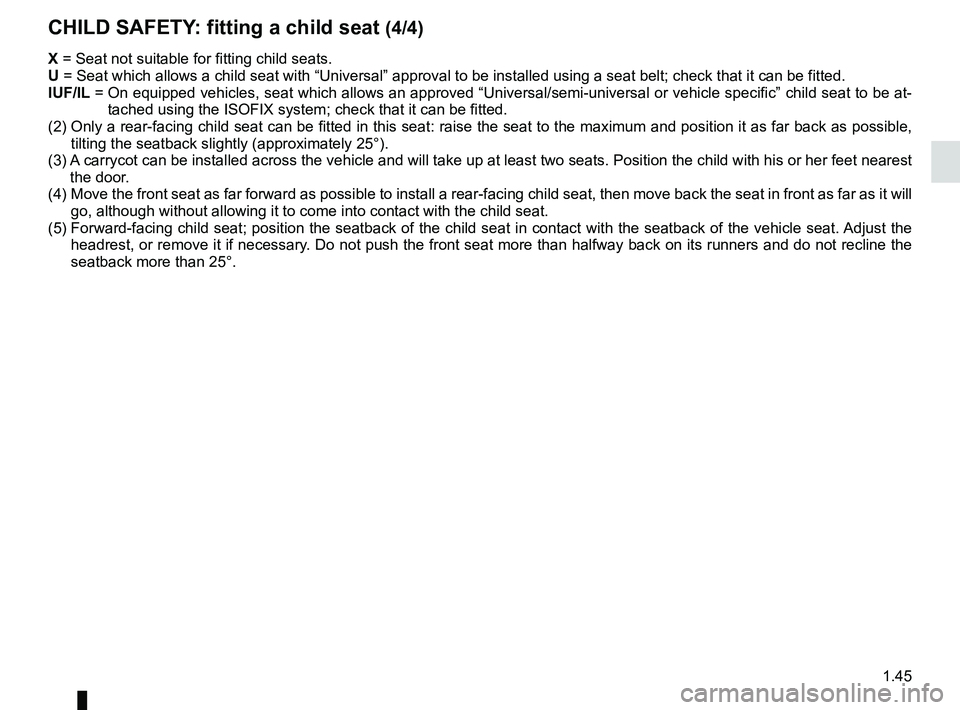
JauneNoirNoir texte
1.45
ENG_UD21488_3
Sécurité enfants : installation du siège enfant (L38 - X38 - R\
enault)
ENG_NU_914-4_L38e_Renault_1
X = Seat not suitable for fitting child seats.
U = Seat which allows a child seat with “Universal” approval to be ins\
talled using a seat belt; check that it can be fitted.
iUF/il = On equipped vehicles, seat which allows an approved “Universal/semi-universal or vehicle specific” child seat to be at-
tached using the ISOFIX system; check that it can be fitted.
(2) Only a rear-facing child seat can be fitted in this seat: raise the seat to the maximum and position it as far back as possible,
tilting the seatback slightly (approximately 25°).
(3) A carrycot can be installed across the vehicle and will take up at least two seats. Position the child with his or her feet nearest
the door.
(4) Move the front seat as far forward as possible to install a rear-facing child seat, then move back the seat in front as far as it will
go, although without allowing it to come into contact with the child sea\
t.
(5) Forward-facing child seat; position the seatback of the child seat in contact with the seatback of the vehicle seat. Adjust the
headrest, or remove it if necessary. Do not push the front seat more than halfway back on its runners and do not recline the
seatback more than 25°.
chilD SAFetY : fitting a child seat (4/4)
Page 51 of 195
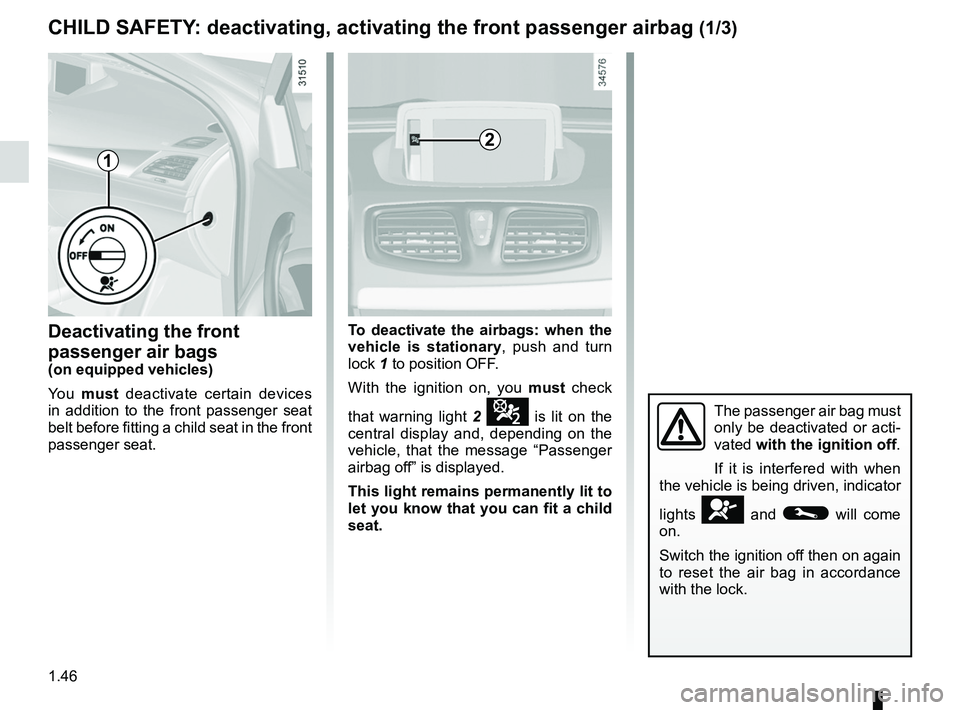
air bagdeactivating the front passenger air bags ........ (current page)
front passenger air bag deactivation ..................... (current page)
child restraint/seat ................................ (up to the end of the DU)
child safety ............................................ (up to the end of the DU)
child restraint/seat ................................ (up to the end of the DU)
transporting children ............................. (up to the end of the DU)
1.46
ENG_UD28761_4
Sécurité enfants : désactivation/activation airbag passager ava\
nt (L38 - X38 - Renault)
ENG_NU_914-4_L38e_Renault_1
Jaune NoirNoir texte
deactivating, activating the front passenger airbag
Deactivating the front
passenger air bags
(on equipped vehicles)
You must deactivate certain devices
in addition to the front passenger seat
belt before fitting a child seat in the front
passenger seat. t
o deactivate the airbags: when the
vehicle is stationary , push and turn
lock 1 to position OFF.
With the ignition on, you must check
that warning light 2
¹ is lit on the
central display and, depending on the
vehicle, that the message “ Passenger
airbag off” is displayed.
this light remains permanently lit to
let you know that you can fit a child
seat.
chilD SAFetY : deactivating, activating the front passenger airbag (1/3)
1
The passenger air bag must
only be deactivated or acti-
vated with the ignition off.
If it is interfered with when
the vehicle is being driven, indicator
lights
å and © will come
on.
Switch the ignition off then on again
to reset the air bag in accordance
with the lock.
2
Page 52 of 195

JauneNoirNoir texte
1.47
ENG_UD28761_4
Sécurité enfants : désactivation/activation airbag passager ava\
nt (L38 - X38 - Renault)
ENG_NU_914-4_L38e_Renault_1
3
chilD SAFetY : deactivating, activating the front passenger airbag (2/3)
A
A
The markings on the dashboard and
labels A on each side of the passen -
ger sun visor 3 (for example, the labels
shown above) will remind you of these
instructions.
A
DANger
S i n c e f r o n t p a s s e n g e r
airbag triggering and the
position of a rear-facing
child seat are incompatible, Never
use a restraining device for rear -
facing children on a seat with an
A ctiv Ate D A irBA g in front of it.
This provides a risk of DeAth or
SeriOUS iNJUr Y to the chilD.
Page 53 of 195
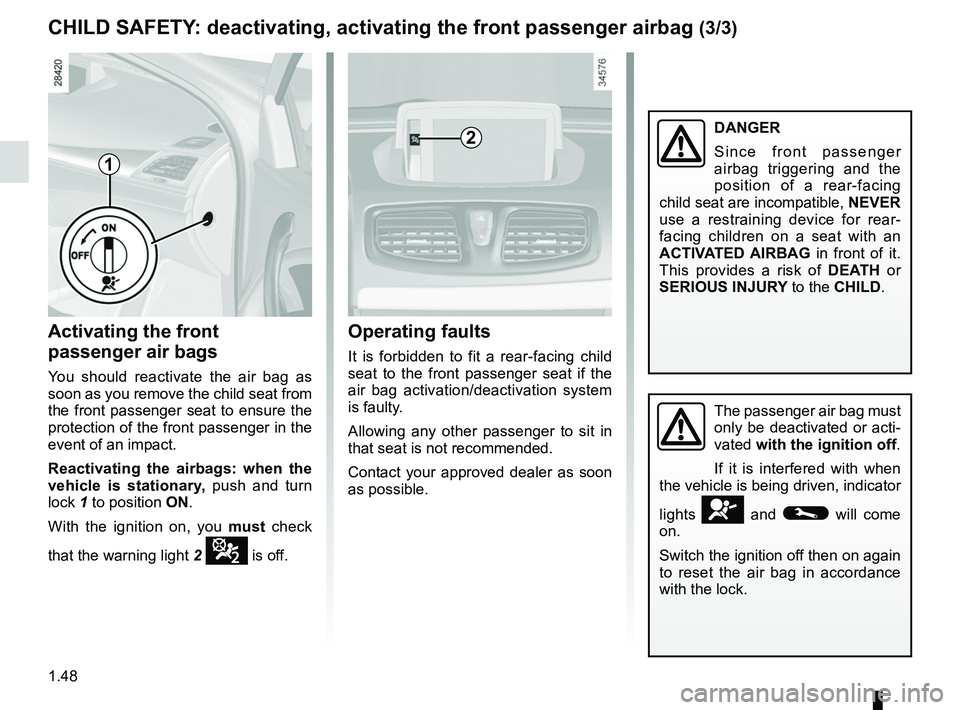
air bagactivating the front passenger air bags ............ (current page)
1.48
ENG_UD28761_4
Sécurité enfants : désactivation/activation airbag passager ava\
nt (L38 - X38 - Renault)
ENG_NU_914-4_L38e_Renault_1
chilD SAFetY : deactivating, activating the front passenger airbag (3/3)
Operating faults
It is forbidden to fit a rear-facing child
seat to the front passenger seat if the
air bag activation/deactivation system
is faulty.
Allowing any other passenger to sit in
that seat is not recommended.
Contact your approved dealer as soon
as possible.
Activating the front
passenger air bags
You should reactivate the air bag as
soon as you remove the child seat from
the front passenger seat to ensure the
protection of the front passenger in the
event of an impact.
r eactivating the airbags: when the
vehicle is stationary, push and turn
lock 1 to position ON.
With the ignition on, you must check
that the warning light 2
¹ is off.
1
The passenger air bag must
only be deactivated or acti-
vated with the ignition off.
If it is interfered with when
the vehicle is being driven, indicator
lights
å and © will come
on.
Switch the ignition off then on again
to reset the air bag in accordance
with the lock.
2DANger
S i n c e f r o n t p a s s e n g e r
airbag triggering and the
position of a rear-facing
child seat are incompatible, Never
use a restraining device for rear -
facing children on a seat with an
A ctiv Ate D A irBA g in front of it.
This provides a risk of DeAth or
SeriOUS iNJUr Y to the chilD.
Page 123 of 195

tailgate .................................................. (up to the end of the DU)
tailgate .................................................. (up to the end of the DU)
transporting objects in the luggage compartment ............................ (current page)
3.20
ENG_UD19267_1
Coffre à bagages (L38 - X38 - Renault)
ENG_NU_914-4_L38e_Renault_3
Boot
T AIlgATE
opening
Press button 1 and lift the boot lid
closing
Lower the boot lid using handle 3 inside
the boot (depending on the vehicle) to
assist you.
1
Transporting objects
lashing hook
Hook 2 enables loads to be secured. Storage tray
Situated under the luggage compart
-
ment carpet - “lift the carpet using
strap 3”
2
3
Always position the heavi -
est items directly on the
floor. The luggage should
be loaded in such a way
that no items will be thrown forward
and strike the occupants if the driver
has to brake suddenly.
Page 135 of 195
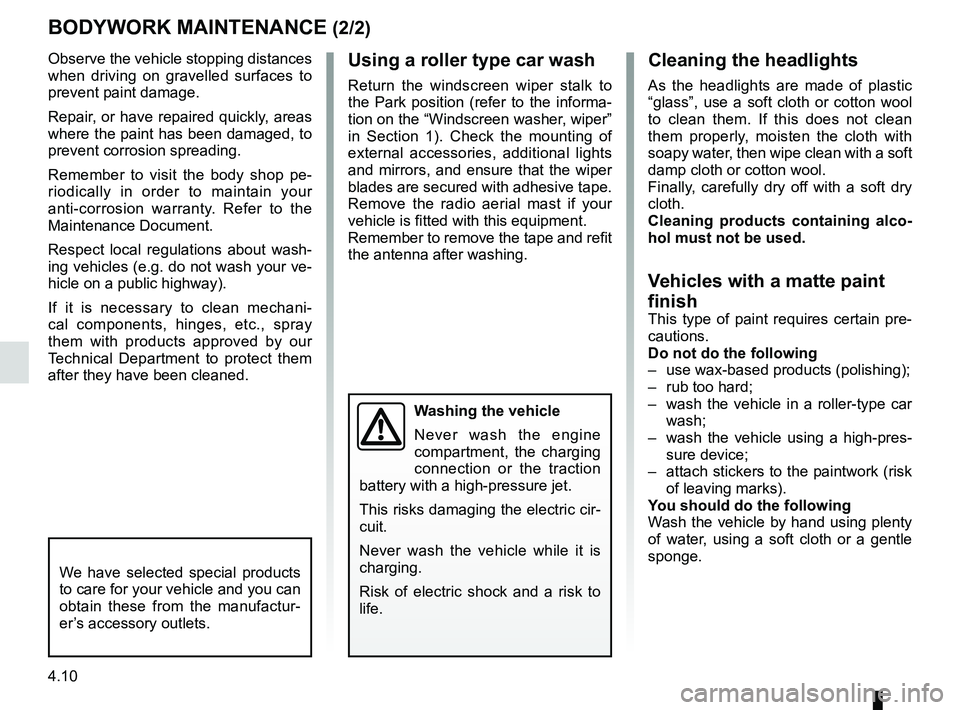
4.10
ENG_UD26559_3
Entretien de la carosserie (X61 - X38 - X61 électrique - L38 élec\
trique - X10 - Renault)
ENG_NU_914-4_L38e_Renault_4
Using a roller type car wash
Return the windscreen wiper stalk to
the Park position (refer to the informa-
tion on the “Windscreen washer, wiper”
in Section 1). Check the mounting of
external accessories, additional lights
and mirrors, and ensure that the wiper
blades are secured with adhesive tape.
Remove the radio aerial mast if your
vehicle is fitted with this equipment.
Remember to remove the tape and refit
the antenna after washing.
Observe the vehicle stopping distances
when driving on gravelled surfaces to
prevent paint damage.
Repair, or have repaired quickly, areas
where the paint has been damaged, to
prevent corrosion spreading.
Remember to visit the body shop pe
-
riodically in order to maintain your
anti-corrosion warranty. Refer to the
Maintenance Document.
Respect local regulations about wash -
ing vehicles (e.g. do not wash your ve-
hicle on a public highway).
If it is necessary to clean mechani -
cal components, hinges, etc., spray
them with products approved by our
Technical Department to protect them
after they have been cleaned.
BODyWORk MaIntenanCe (2/2)
Cleaning the headlights
As the headlights are made of plastic
“glass”, use a soft cloth or cotton wool
to clean them. If this does not clean
them properly, moisten the cloth with
soapy water, then wipe clean with a soft
damp cloth or cotton wool.
Finally, carefully dry off with a soft dry
cloth.
Cleaning products containing alco -
hol must not be used.
vehicles with a matte paint
finish
This type of paint requires certain pre-
cautions.
Do not do the following
– use wax-based products (polishing);
– rub too hard;
– wash the vehicle in a roller-type car
wash;
– wash the vehicle using a high-pres-
sure device;
– attach stickers to the paintwork (risk
of leaving marks).
y ou should do the following
Wash the vehicle by hand using plenty
of water, using a soft cloth or a gentle
sponge.
We have selected special products
to care for your vehicle and you can
obtain these from the manufactur -
er’s accessory outlets.
Washing the vehicle
Never wash the engine
compartment, the charging
connection or the traction
battery with a high-pressure jet.
This risks damaging the electric cir-
cuit.
Never wash the vehicle while it is
charging.
Risk of electric shock and a risk to
life.
Page 139 of 195

tyre inflation kit....................................................... (current page)
tool kit ................................................... (up to the end of the DU)
5.2
ENG_UD23031_2
Bloc outils, kit de gonflage : accès (L38 électrique - Renault)
ENG_NU_914-4_L38e_Renault_5
Jaune NoirNoir texte
Tool kit
TOOL KIT (1/2)
the tool kit contains tools and the tyre
inflation kit. It is located in the boot.
To get to it:
– remove strap 1 and attach it 2.
– position your hands at A and B;
– pull the kit 3 towards you.
To use the tyre inflation kit, please refer
to “Tyre inflation kit” in Section 5.
Do not leave the tools un -
secured inside the vehicle
as they may come loose
under braking. After use,
check that all the tools are correctly
clipped into the tool kit, then position
it correctly in its housing: there is a
risk of injury.
1
2
B
A3
Inflation kit
To use the tyre inflation kit, please refer
to “Tyre inflation kit” in Section 5.
Page 140 of 195

wheelbrace ............................................................ (current page)
hubcap tool ............................................................ (current page)
jack ........................................................................\
(current page)
wheelbrace ............................................................ (current page)
towing hitch ............................................................ (current page)
trims ....................................................................... (current page)
JauneNoirNoir texte
5.3
ENG_UD23031_2
Bloc outils, kit de gonflage : accès (L38 électrique - Renault)
ENG_NU_914-4_L38e_Renault_5
Wheel trim
TOOL KIT (2/2)/TrIm
ToolsThe composition of the tool kit varies
according to the vehicle.
rear lights key 4
Used to unscrew the rear lights.
Front headlight key 5
Used to unscrew the headlights.
Wheelbrace 6
Never leave tools unsecured in the vehicle: there is a risk that they may
be thrown about during braking. After use, check that all the tools are
correctly clipped into the tool kit, then position it correctly in its housing:
there is a risk of injury.
Jack 7
When replacing the jack, fold it cor -
rectly and position the wheelbrace cor-
rectly before replacing it in its position.7
6
8
9
10
4
The jack is designed for
wheel changing purposes
only. Under no circum -
stances should it be used
for carrying out repairs underneath
the vehicle or to gain access to the
underside of the vehicle.
Hubcap tool 8
This tool is used to remove the wheel
trims.
Wheel bolt guide 9
To finish loosening or starting to tighten
the wheel bolts.
Tow eye 10
Refer to the information on “Towing” in
Section 5.Wheel trim
Remove it using the hubcap tool 8 by
connecting the hook in the recess pro-
vided next to the valve 11 (to attach the
metal clip).
To refit the wheel trim, align it with
valve 11 . Push the retaining hooks in
fully, starting with side C near the valve,
followed by D and E, finishing at F op-
posite the valve.
NB: if you are using anti-theft bolts,
refer to the information on “Changing a
wheel”.
11
C
DE
F
5
Page 143 of 195
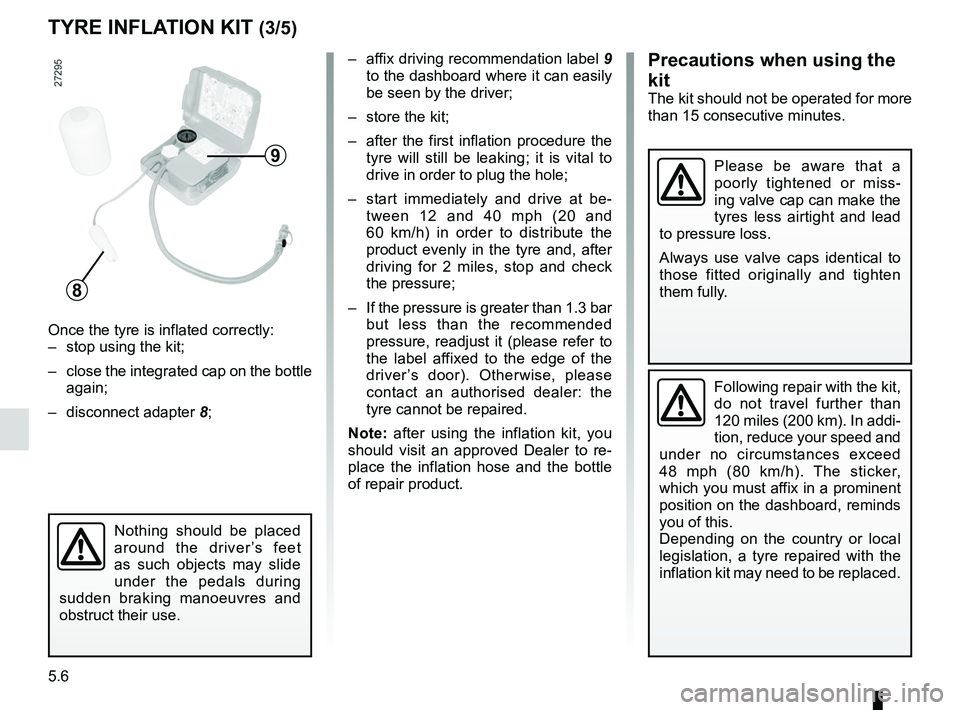
5.6
ENG_UD28764_1
Kit de gonflage des pneumatiques (L38 électrique - Renault)
ENG_NU_914-4_L38e_Renault_5
Jaune NoirNoir texte
TYrE INFLATION KIT (3/5)
9
8
– affix driving recommendation label 9
to the dashboard where it can easily
be seen by the driver;
– store the kit;
– after the first inflation procedure the
tyre will still be leaking; it is vital to
drive in order to plug the hole;
– start immediately and drive at be -
tween 12 and 40 mph (20 and
60 km/h) in order to distribute the
product evenly in the tyre and, after
driving for 2 miles, stop and check
the pressure;
– If the pressure is greater than 1.3 bar
but less than the recommended
pressure, readjust it (please refer to
the label affixed to the edge of the
driver ’s door). Otherwise, please
contact an authorised dealer: the
tyre cannot be repaired.
Note: after using the inflation kit, you
should visit an approved Dealer to re -
place the inflation hose and the bottle
of repair product.Precautions when using the
kit
The kit should not be operated for more
than 15 consecutive minutes.
Nothing should be placed
around the driver ’s feet
as such objects may slide
under the pedals during
sudden braking manoeuvres and
obstruct their use.
Once the tyre is inflated correctly:
– stop using the kit;
– close the integrated cap on the bottle
again;
– disconnect adapter 8;
Following repair with the kit,
do not travel further than
120 miles (200 km). In addi -
tion, reduce your speed and
under no circumstances exceed
48 mph (80 km/h). The sticker,
which you must affix in a prominent
position on the dashboard, reminds
you of this.
Depending on the country or local
legislation, a tyre repaired with the
inflation kit may need to be replaced.
Please be aware that a
poorly tightened or miss -
ing valve cap can make the
tyres less airtight and lead
to pressure loss.
Always use valve caps identical to
those fitted originally and tighten
them fully.